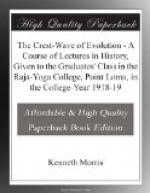And meanwhile, though the huge Greek illumination could die but slowly, Greece was growing uninteresting. For Pheidias of the earlier century, we have in Plato’s time Praxiteles, whose carved gods are lounging and pretty nincom—– well, mortals; “they sink,” says the Encyclopedia, “to the human level, or indeed, sometimes almost below it. They have grace and charm in a supreme degree, but the element of awe and reverence is wanting.”—We have an Aphrodite at the bath, a ‘sweet young thing’ enough, no doubt; an Apollo Sauroctonos, “a youth leaning against a tree, and idly striking with an arrow at a lizard.” A certain natural magic has been claimed for Praxiteles and his school and contemporaries; but if they had it, they mixed unholy elements with it.—And then came Alexander, and carried the dying impetus eastward with him, to touch India with it before it quite expired; and after that Hellenism became Hellenisticism, and what remained of the Crest-Wave in Greece was nothing to lose one little wink of sleep over.
VII. THE MAURYAS OF INDIA
“Some talk of Alexander” may be appropriate here; but not much. He was Aristotle’s pupil; and apart from or beyond his terrific military genius, had ideas. Genius is sometimes, perhaps more often than we suspect, an ability to concentrate the mind into a kind of impersonality; almost non-existence, so that you have in it a channel for the great forces of nature to play through. We shall find that Mr. Judge’s phrase ‘the Crest-Wave of Evolution’ is no empty one: words were things, with him and in fact, as he says; and it is so here. For this Crest-Wave is a force that actually rolls over the world as a wave over the face of the sea, raising up splendors in one nation after another in order geographically, and with no haphazard about it. Its first and largest movement is from East to West; producing (as far as I can see) the great manvantaric periods (fifteen hundred years apiece) in East Asia, West Asia, and Europe; each of these being governed by its own cycles. But it has a secondary movement as well; a smaller motion within the larger one; and this produces the brilliant days (thirteen decades long for the most part) that recur in the manvantaras. Thus: China seems to have been in manvantara from 2300 to 850 B. C.; West Asia, from 1890 to 390; Europe, from 870 B. C. to 630 A. D. So in the time of Alexander West Asia was newly dead, and China waiting to be reborn. The Crest-Wave, in so far as it concerned the European manvantara, had to roll westward from Greece (in its time) to awaken Italy; but in its universal aspect—in its strongest force—it had to roll eastward, that its impulse might touch more important China when her time for awaking should come. It is an impetus, of which sometimes we can see the physical links and lines along which it travels, and sometimes we cannot. The line from Greece to China lies




